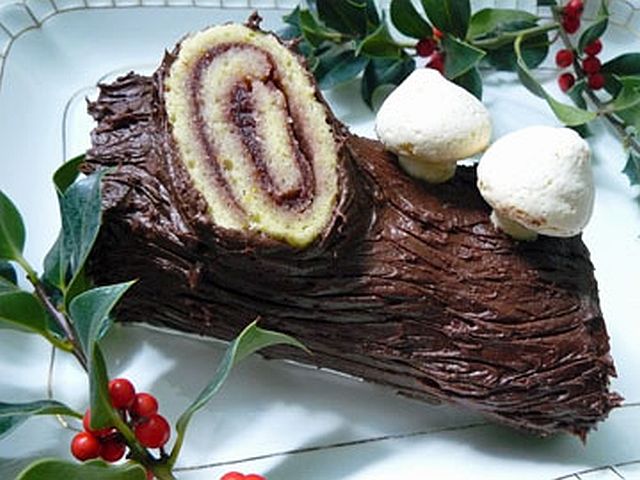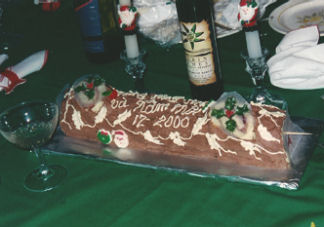When I was growing up, my crafty, food-obsessed mother (see where I get it from?) baked roughly two dozen yule logs each year to gift neighbors, friends, and valued clients of her sewing business. She was a whiz with her French sewing techniques so why not showcase her French baking skills? Mom is an over achiever. Call her the "Vietnamese yule log lady".
My siblings and father joined in to help my parents bake and decorate the cakes during many of the 25 years of bánh khúc cây giáng sinh (Christmas tree section cake) madness that went on in our home. Mom would bake the sponge cakes, fill them with jam and roll them up. Then she’d prepare butter cream and my sister Linh would make meringue mushrooms. We called the called by simply as "banh buche".
When the frosting was ready and split into different colors and flavors, Yenchi, Linh, and I would fashion roses from the pink butter cream. Chocolate butter cream got spread all over the logs and one of us (either Tasha or Dan) would drag a fork through the frosting to mimic bark. My father loaded up a pastry bag and wrote Happy Holidays or Merry Xmas on the cakes. Then we’d add vines, leaves, and affix our roses. The meringues went on last and then my dad would load up the car and deliver them to people around town. One of us had to sit with the cakes to ensure they didn’t slide around too much.
Around the year 2000, my mother quit making yule logs. The photo above was the last time she was the log lady. To prevent drying during refrigeration, the cut ends of cake are protected with wax paper pinned onto the cake with toothpicks. A Chinese baker at the local supermarket sold my folks a bunch of plastic Christmas decor so they often adorned their logs with fake holly, candied Santas and the like. A little kitschy and extremely festive.
Nowadays when I revive my family's yule log tradition, I make an almond and tangerine cake filled with raspberry jam and frosted with a deep chocolate frosting. Oh yes, there are meringues flavored with tangerine zest. The photo at the top of this article represents one of two small ones but you can make one long one with two 'stumps.'
I’ve no ambition to recreate the décor of my youth. We don't have children to impress into duty. However, this is a simple cake. You can make it in stages and invite others to help out. The result is impressive and well, you can let your inner crafty self go wild. Here's a yule log cake countdown:
- 2 to 7 days out: make meringues
- Up to 2 days before serving: make cake, frosting, and frost cake
- Right before serving: add finishing garnishes
If you've never made this cake, review the homemade sponge cake recipe (banh bong lan) for background information. If you need an solid, affordable electric hand mixer, I am loving this one by OXO with a light that helps you see what's going on in the bowl.
Some yule log cake pointers for prep work:
- Before starting, prep the pan. Use a 10 by 15-inch "jelly roll" rimmed baking sheet. To prepare the pan, smear a bit of softened butter to lightly coat the bottom and side. Line the bottom with parchment paper. Smear the parchment paper with a bit more butter. Add about ⅓ cup flour and shake and turn the pan around to coat it. Standing over the sink, invert and tap the pan to remove excess flour. Set aside.
- The cake-batter making whizzes by fast. Have your mixer and rubber spatula handy. Gather the ingredients and organize yourself so you can move swiftly and smoothly through the process.
RECIPE
Yule Log Cake
Banh Buche de Noel (Banh Khuc Cay Giang Sinh)
Yields: 1 cake for 8 or 2 small cakes for 4 people each
Ingredients
For egg yolk batter base:
¼ cup heavy whipping cream
3 tablespoons unsalted butter, cut into 3 chunks
3 large egg yolks, placed in a metal bowls, about 3-quart capacity
½ cup sugar
1 ½ teaspoons pure almond extract
1 ½ teaspoons grated tangerine, lemon, or lime peel (use a microplane and the colored outer part only, exclude pith)
⅓ cup plus ½ cup bleached cake flour, scooped and leveled into a sifter set over a piece of parchment or plate
For egg whites:
3 large egg whites, place in a metal bowl, 2-3-quart capacity
Pinch of salt, non-iodized table salt, preferred
Scant ¼ teaspoon cream of tartar (purchase from grocery store in spice section)
1 ½ tablespoons sugar
⅓ cup powdered sugar
1 cup raspberry jam, preferably low sugar
1 tablespoon rum or juice from the citrus you zested
1 recipe Chocolate Butter Cream Frosting
8 to 12 Tangerine Meringue Kisses made into mushrooms
Holly sprigs, optional decor
Method:
- Butter, line, then flour a jelly-roll pan as explained in the pointers and set aside. Set a rack in the lower third position and preheat to 375F. Put the cream and butter in a small saucepan and heat until the butter has just melted. Remove from the heat and set aside.
- Start beating the egg yolks in the bowl. Gradually sprinkle in the sugar by the tablespoon to incorporate well. (Do this too fast and the batter will be grainy with sugar.) Continue beating for several minutes, until the mixture is thick, pale yellow, and when you pause and lift the whisk (or beaters), the batter drips down and forms a ribbon that slowly dissolves on the surface. Now, beat in the almond extract and grated zest. Reduce the mixer speed to low if necessary and beat in the cream and butter, stopping as soon as they have been incorporated. Turn off the mixer, remove the beaters. In 3 or 4 batches, sift the flour directly onto the batter, stirring it in each time with a spatula before adding more flour. Set aside.
- Wash and dry the beaters well.
- Start beating the egg whites. When they are foamy throughout, sprinkle in the salt and cream of tartar. Continue beating until soft peaks form (when the whisk (or beaters) is lifted out of the egg whites, a soft, slightly bent over peak of egg white forms in the bowl). As you beat, the whites will have gone from clear to light grey to solid white. Instead of sliding from the walls of the bowl, they will stick to the bowl.
- After soft peaks form, sprinkle in the 1 ½ tablespoons sugar and continue beating for a couple more minutes to generate stiff egg whites (the peak stands straight when the whisk is lifted from the bowl). The whites will have a sheen.
- Immediately take a large rubber spatula and plop a ¼ of the egg whites onto the egg yolk base. Stir gently to lighten the base. Then quickly fold in the remaining egg whites in 3 batches. (To fold, plunge the spatula sideways -- like a knife -- into the center of the batter, touching bottom. Rapidly bring the spatula to the wall of the bowl and rotate it to scoop up and fold the batter over the whites and flour. Do this several times.) The finished batter will be pale yellow, very thick, and light feeling.
- Pour the batter into the prepared cake pan. Spread it out with the spatula to the edge. Then tap it on the counter to evenly distribute the batter.
- Immediately slide the cake into the oven. Bake for about 10 minutes. The cake will rise and it is done when it is lightly colored and the top feels springy. The edge may be light brown. It will be just cooked. Overbaking dries the cake and it will crack when rolled.
- While the cake bakes, put ⅓ cup powdered sugar in a sifter. Have a lightly dampened dishtowel handy and cut a piece of parchment larger than the size of the baking sheet.
- Remove the cake from the oven and place on a work surface. You are now going to trim and unmold the cake so that it doesn’t crack when rolled.
- Take a knife and cut off about ¼ inch from the long sides. Sift half of the powdered sugar on the cake surface. Put the parchment paper on top and then cover with the dishtowel. Put a baking sheet on top and now turn the trays upside down to unmold the cake. Remove the warm baking sheet and peel away the parchment but reserve. Sift the remaining powdered sugar onto the cake surface and then replace the parchment paper. Fold up the sides of the dishtowel and let the cake cool for about 15 minutes.
- Meanwhile, heat the jam up with the rum just so that the jam is soft enough to easily spread. When the cake is cool to around lukewarm, remove the top parchment paper. Spread the jam to cover the top of the cake and then roll up the cake. Gently roll it up in the remaining parchment and set aside to cool. Cover with plastic wrap and refrigerate up to 2 days in advance. Return to room temperature before frosting.
- Before frosting the cake, cut a piece of cardboard that’s as long as the cake but slightly narrower than it. Cut it into two if you are making 2 small cakes. Cover the cardboard with foil and use this as your cake base.
- Unwrap the cake. To mimic a sawed log, use a knife to diagonally cut off about ¾ to 1 inch of each end. Make both cuts at roughly the same angle. Set aside these two scrap pieces. If making two cakes, cut the roll in half at an angle.
- Whether you make one large or two small cakes, frosting it is the same. Smear a bit of frosting down the center of the cardboard. Put the cut roll atop. Use a metal icing spatula to smear some frosting on the uncut end of one of the scrap pieces. Affix it to the roll to create a short branch. Do the same with the other scrap piece. Now frost the cake, leaving the cut portions unfrosted so guests see the ‘tree rings.’ Hold up the cake by the cardboard base to easily get the bottom covered. Lightly drag the tines of a fork through the frosting to simulate tree bark. The cake can refrigerated at this point for up to 2 days. Put small pieces of parchment or wax paper on the exposed cake areas to prevent drying; toothpicks should keep the paper in place.
- Return the cake to room temperature before serving. Put on serving platter. Garnish with clusters of meringue mushrooms placed upon the log or around the log. Decorate with holly, if available or other holiday decorations. Serve immediately.
Related posts



















Priscilla M says
The Yule Log is a Scandinavian tradition, not a VIetnamese one. And the tradition of making a yule log cake is from central Europe. Are there any concerns here about cultural appropriation?
Andrea Nguyen says
Of course this is a European tradition introduced to Vietnam, hence the French name in the post title. But the cake has become part of many people's tradition. Viet people do not say it is Vietnamese. It's more an expression of cultural appreciation. Vietnamese people have had to appropriate from foreign colonizers, for example banh mi, as a form of cultural survival. Indeed, these matters are complex!